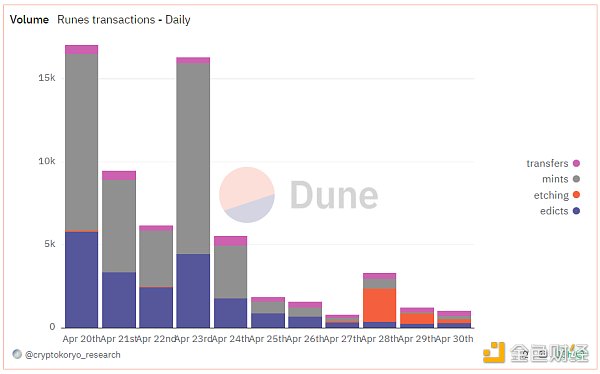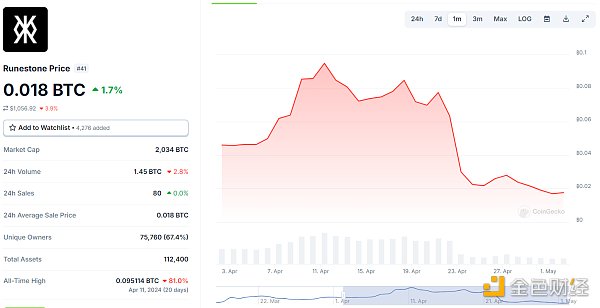Author: Socra, Golden Finance
With the arrival of Bitcoin halving, the Runes protocol was officially launched. It was thought that the Bitcoin ecosystem could use this to set off the third wave, but surprisingly, many rune ecosystem projects reached their peak as soon as they debuted. Many investors suffered heavy losses from casting runes, and the price of inscriptions in the secondary market was almost halved.
Looking back at the eve of the launch of the runes, it can be said that everyone was looking forward to it. The floor price of Runestone rose to 0.095 BTC, many projects established pledge airdrop rune rules, and community members prepared their wallets in advance. However, the Runes protocol, which claims to surpass BRC-20, does not seem to have escaped the law of death due to popularity, and has not even brought considerable returns to early inscription new investors like the ordinarys protocol.
The two-level reversal is that investors who were optimistic about the Runes protocol before have gradually questioned the innovativeness of its technology. At this time, OKX stood up and first announced the launch of RUNECOIN (RSIC•GENESIS•RUNE) on OKX Jumpstart on April 29, and officially launched the project spot the next day, which undoubtedly brought some confidence to rune investors. But will the rune track get better?
On the day of launch, the market crashed
On April 20, the Bitcoin halving came, and at the same time the Runes protocol was launched. Casey Rodarmor, the creator of the protocol, hard-coded the rune "UNCOMMON•GOODS" he deployed in the Runes protocol, and the other 9 runes were no longer hard-coded into the Runes protocol because the token names were not very creative. This made big investors and institutions see the wealth opportunity, and they rushed to play, which once caused the gas price to soar.
But the high expectations and high costs did not bring equal returns. Since the launch of the Runes protocol, many rune projects have experienced a short highlight moment and then quickly fell, and only a few head runes performed well. According to the chart provided by Dune user @cryptokoryo_research, since the rune transaction volume on the Bitcoin network on April 20, it only reached its peak on April 23, with the daily transaction volume of Runes exceeding 750,000 transactions, but it has since declined all the way to 93,000 transactions on April 30.

By splitting the various steps of the Runes protocol, we can more intuitively see the significant degree of decline in the various rune data. Among them, the decline in rune casting is the most obvious, which is mainly due to the surge in on-chain transaction fees and the decline in the market performance of rune projects.
Runestone, a star project before the launch of the Runes protocol, once ranked second in the NFT market value ranking, second only to CryptoPunks. This surprised countless investors at the explosive power of runes, and at the same time they were full of expectations for its prospects. However, it didn't take long for Runestone to remain strong.

According to Coingecko data, the floor price of Runestone soared to 0.095 BTC on April 11, but it fell almost straight from 0.0775 BTC on April 21 to only 0.018 BTC, a drop of 81%.
On the other hand, the other rune projects with higher community popularity still cannot avoid the fate of falling.
As of the time of writing, according to OKX data, the average price of Rune No. 1 Z•Z•Z•Z•Z•FEHU•Z•Z•Z•Z•Z reached its peak as soon as it debuted, with a total trading volume of 14.94 BTC, of which the trading volume peaked on April 24 at 6.45 BTC, and the trading volume on April 30 was only 0.33 BTC. The current floor price is 37,990 sats (worth approximately US$24.22).
91% of the total amount of Rune 2 DECENTRALIZED was allocated to the Pre-Rune series Prometheans, but Prometheans fell sharply after the snapshot. The floor price has fallen from the high point of 0.0845 BTC and is currently 0.016 BTC.
Rune 3 DOG•GO•TO•THE•MOON was launched on Gate.io on April 25. The token name is DOG. Its price has risen all the way to 0.0057 US dollars, but it is currently only 0.00315 US dollars.
The 9th rune LOBO•THE•WOLF•PUP is also listed on Gate.io, with a maximum price of $0.0028, but the current price is $0.0009.
Among the many rune projects, only the 1st symbol Z•Z•Z•Z•Z•FEHU•Z•Z•Z•Z•Z, the 3rd symbol DOG•GO•TO•THE•MOON and the 8th rune RSIC•GENESIS•RUNE have a market value of over 100 million, the 4th rune THE•RUNIX•TOKEN and the 2nd rune DECENTRALIZED have a market value of over 50 million US dollars, and the rest are lower than this figure.
Under the tide: low recognition, over-hype, lack of innovation
The overall performance of the rune sector has been disappointing so far, which is due to both its own lack of technological innovation and excessive hype in the external market.
First of all, the rune itself has MEME attributes, but the recognition is not high. On April 21, Casey Rodarmor liked the no pre-mining mechanism of the rune WANKO•MANKO•RUNES project, causing the latter's price to rise by more than 450% on the same day. Casey also posted on social media that "Runes are built for Degen and Memecoin", but all rune names are currently very long and very unfriendly to non-English users.
The Ordinal Theory Handbook stipulates that rune names must be between 1 and 28 characters, the length limit can only use letters from A to Z, and the name must be unique, regardless of whether there are spaces. The initial 4 months after launch will be at least 13 letters, and then it will be reduced by 1 every four months. This means that it will only reduce 3 letters in a year.
For this point, Casey said that the Runes protocol has a built-in minimum name length to prevent so-called name squatting, which is mainly attributed to the idea of a unique name.
But this type of rune is obviously less popular than catchy MEMEs such as DOG, SHIB, and PEPE.
Secondly, the runes were overdrawn and hyped before they were launched. As early as December last year, Casey announced that the Runes protocol mainnet will be launched along with the Bitcoin halving. There is a gap of nearly 5 months between them, which is enough for various capitals to hype up related concept projects.
In particular, the inscription wealth effect brought by the Ordinals protocol has made many investors full of FOMO emotions. Based on the principle of preferring to sell wrong rather than miss out, bets were placed on the eve of the launch of the Runes protocol. The crypto market has a tradition of buying news and selling facts, so when an event really happens, the real trader has already begun to close the net and prepare to catch fish.
The most obvious example is the above-mentioned Runestone. With the completion of the Runestone snapshot on April 22, each Runestone NFT held by block 840,269 users can obtain 889,806 DOG•GO•TO•THE•MOON runes (Rune No. 3), and the floor price of the project fell by 59.5% in 24 hours.
Finally, although Casey Rodarmor repeatedly belittled the BRC-20 protocol and touted the Runes protocol as safer, simpler and more efficient, its technology itself is not very innovative for the Bitcoin network. And long before the Runes protocol, there was a similar Atomicals protocol.
For example, KOL @白菜 once wrote that Casey lacked basic respect for BRC20 and its creator domo, who promoted Ordinals. He enjoyed the aura and traffic brought by BRC20 but hated the standard. At the same time, he borrowed the idea of the UTXO-base protocol from Atomicals to create Runes, but never mentioned it.
In addition, compared with inscriptions, the fairness of runes is also questionable. Most inscriptions on the market adopt the Fair Launch method, but in rune projects, there are more or less reservations. And the top-ranked runes are usually snatched by institutions or big players.
Conclusion
The inscription wealth effect brought by the Ordinals protocol has made the crypto market begin to believe that the Bitcoin ecosystem can be further developed and mined, but the current market performance of the rune sector can be said to have poured cold water. This is not only affected by the overall crypto market, but also by its own lack of product strength.
The current good news for the rune track includes: exchanges including OKX have launched rune tokens, OKX Ventures has cooperated with OnePiece Labs, Merlin Chain and Franklin Templeton to support the Runes incubator, RuneChain has launched rune cross-chain bridges, exchanges, etc.
In short, the ecological infrastructure around the rune sector is under construction. And at the current data level, the head rune projects have a trend of stabilizing and warming up. Therefore, investors do not have to be overly pessimistic, and may wish to continue to observe the progress of the Runes protocol.
 JinseFinance
JinseFinance
 JinseFinance
JinseFinance JinseFinance
JinseFinance JinseFinance
JinseFinance decrypt
decrypt Bitcoinist
Bitcoinist Bitcoinist
Bitcoinist Cointelegraph
Cointelegraph Cointelegraph
Cointelegraph Bitcoinist
Bitcoinist Cointelegraph
Cointelegraph